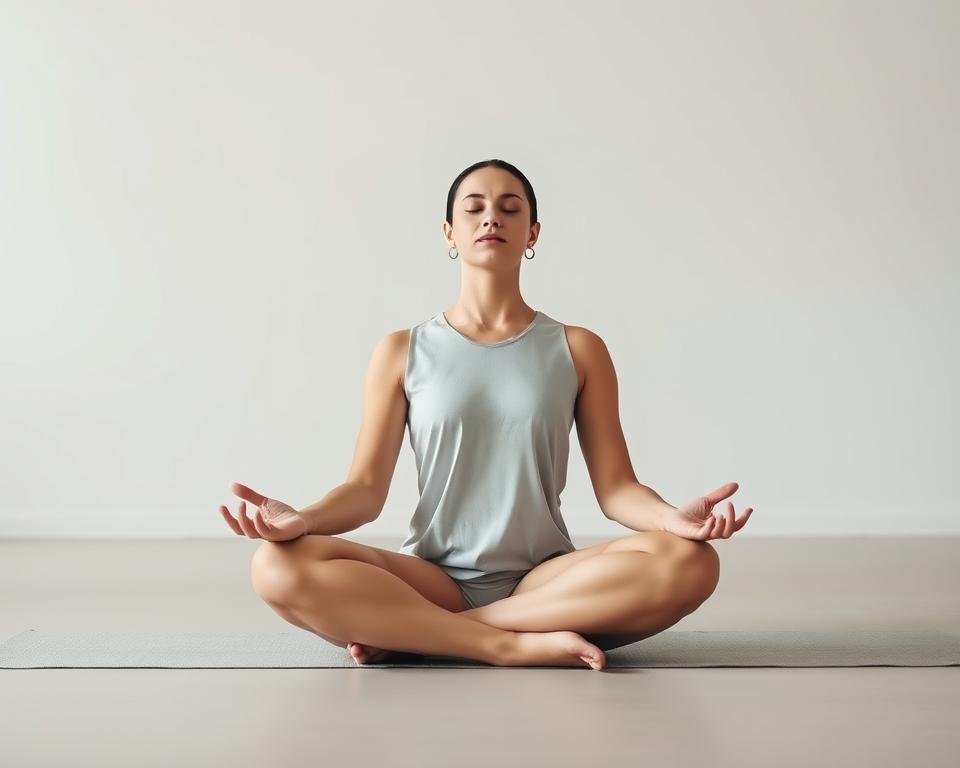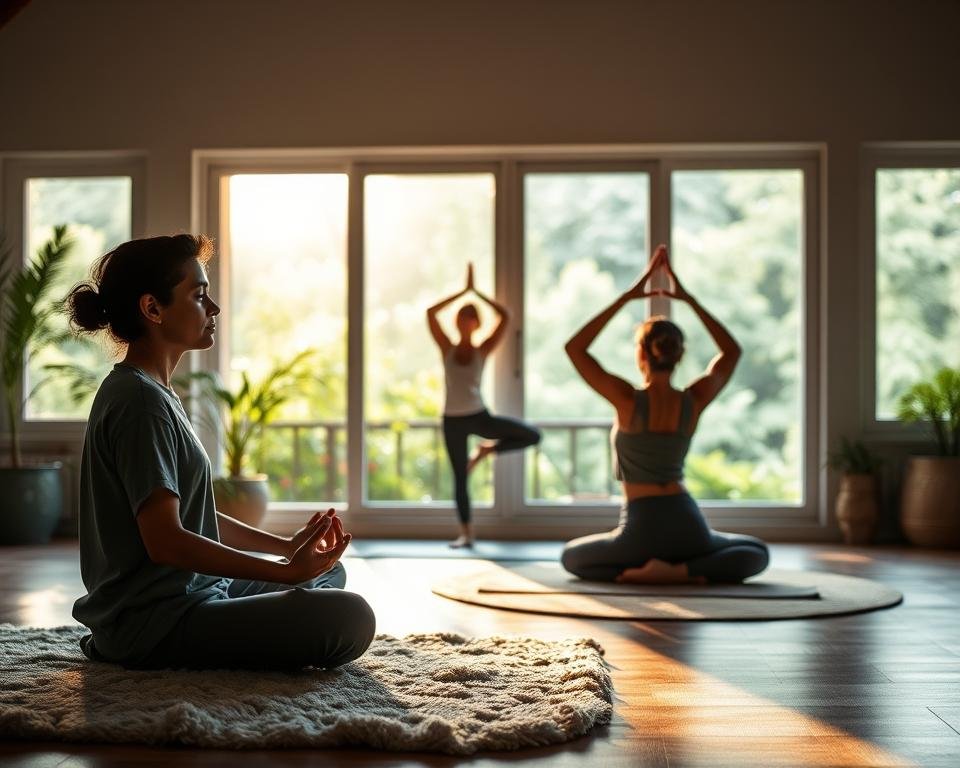Exploring mindfulness is exciting. I want to share key techniques that can change your life. This practice helps you feel more aware and calm every day.
Adding mindfulness techniques to your day can lower stress and anxiety. This makes life more balanced and fulfilling.
Key Takeaways
- Reduce stress and anxiety with mindfulness practices
- Improve emotional regulation and well-being
- Enhance focus and concentration
- Cultivate a deeper sense of awareness and calm
- Improve overall mental health
What is Mindfulness?
Mindfulness means being in the moment. It’s about noticing your thoughts, feelings, and body without judging. This helps people understand themselves and the world better.
Understanding the Concept
Mindfulness comes from ancient Buddhist meditation. But it has grown and changed over time. It’s now used in many everyday ways. The main idea is to be fully present and observe without getting caught up.
Mindfulness practices include meditation and deep breathing. These help you find awareness and calm.
The Benefits of Mindfulness
The benefits of mindfulness are many and proven. Adding mindfulness to your day can lower stress and anxiety. It also improves how you feel and think.
| Benefit | Description |
|---|---|
| Reduced Stress | Mindfulness lowers stress hormones like cortisol. |
| Improved Focus | It makes your attention and concentration better. |
| Emotional Regulation | Mindfulness helps manage emotions for better well-being. |
Learning and practicing mindfulness can make life more balanced and fulfilling.
The Science Behind Mindfulness
Exploring the science of mindfulness, I find a lot of research. Mindfulness meditation is a big area of study. Many benefits have been found.
Scientists have been studying mindfulness a lot. The results are very interesting. They show that regular mindfulness can change the brain’s structure and function.
Research Findings
Research on mindfulness shows many benefits. These include less stress, better emotional control, and better thinking. For example, a study in the Journal of the American Medical Association found it helps with anxiety and depression.
Other studies show mindfulness can make the brain’s gray matter better. This means better memory and learning, even in older people. This is very important.

How Mindfulness Affects the Brain
Mindfulness meditation changes the brain in important ways. It makes areas for attention and emotional control work better. It also makes areas for stress and anxiety work less.
Neuroimaging studies show mindfulness changes the brain’s structure. This is in areas for memory and learning. It can make thinking better and lower the risk of losing cognitive abilities with age.
Understanding how mindfulness changes the brain helps us see its benefits. It can be used in daily life through meditation or other practices. Mindfulness can greatly improve both mental and physical health.
Simple Mindfulness Techniques to Start With
Let’s explore some easy mindfulness techniques to start your journey. Adding mindfulness to your day can be simple and rewarding. Two great techniques to begin with are breathing exercises and body scan meditation.

Breathing Exercises
Breathing exercises are a basic mindfulness technique. You can do them anywhere, anytime. Sit comfortably, close your eyes, and breathe slowly.
Focus on how your breath feels moving in and out. If your mind drifts, gently bring it back to your breath. Don’t judge yourself.
Benefits of Breathing Exercises: They can lower stress, improve focus, and make you feel calmer.
- Start with short sessions (5-10 minutes) and increase as you get more comfortable.
- Use a timer to keep your practice regular.
- Practice at the same time each day to make it a habit.
| Breathing Technique | Description | Benefits |
|---|---|---|
| Diaphragmatic Breathing | Use your diaphragm to breathe deeply into your belly. | Reduces stress, promotes relaxation. |
| 4-7-8 Breathing | Breathe in for 4 seconds, hold for 7, and out for 8. | Helps with sleep, reduces anxiety. |
Body Scan Meditation
Body scan meditation involves lying down or sitting comfortably. Focus on different parts of your body, starting from your toes and moving up to your head. Notice any sensations, tension, or discomfort without trying to change them.
Practicing Body Scan Meditation: This technique helps you become more aware of your body and release tension. It’s also great for relaxation and stress relief.
- Find a quiet, comfortable space where you can relax without distractions.
- Start at your toes and gradually bring your attention up through your body.
- Notice any areas of tension and try to release them as you exhale.
By adding these simple mindfulness techniques to your daily routine, you can increase awareness and calm. Whether you want to reduce stress, improve focus, or feel more grounded, breathing exercises and body scan meditation are excellent starting points.
Mindfulness in Daily Life
Mindfulness can change how we think and focus. It’s not just for meditation. It can be part of our daily lives.
Practicing at Work
Mindfulness at work lowers stress and boosts productivity. Here are some mindfulness tips for work:
- Take short breaks to breathe and refocus.
- Practice mindful listening during meetings.
- Focus on one task at a time to improve concentration.
Being Mindful While Eating
Eating mindfully makes meals special. Try these mindfulness practices:
- Eat slowly and enjoy each bite.
- Notice the colors, textures, and smells of your food.
- Turn off the TV and put away your phone to avoid distractions.

Mindful Commute Tips
Commuting can be stressful, but mindfulness can make it relaxing. Here are some tips:
- Listen to calming music or nature sounds.
- Do deep breathing exercises.
- Watch your surroundings without judgment.
Mindfulness in daily life is easy. It’s about small changes to be more present. This way, you can live a more balanced and happy life.
Mindfulness Meditation Practices
Mindfulness meditation helps you find inner peace and awareness. Spend a few minutes each day on these practices. You’ll feel calmer and clearer in your life.
Guided Meditations
Guided meditations are a great start for beginners. You listen to a soft voice that guides you to relax and focus. They help beginners stay on track.
Start with guided meditations by checking out apps and online sites. They have sessions for stress, sleep, and emotional balance.

Loving-Kindness Meditation
Loving-kindness meditation, or Metta meditation, grows love and kindness in you. You repeat phrases to feel warmth and understanding.
To do loving-kindness meditation, sit comfortably. Say “May I be happy, may I be healthy, may I be at peace.” Then, wish the same for others, including friends and family.
| Meditation Practice | Benefits | Tips for Beginners |
|---|---|---|
| Guided Meditations | Reduces stress, improves focus | Start with short sessions, use apps |
| Loving-Kindness Meditation | Cultivates compassion, enhances emotional well-being | Begin with self-directed kindness, gradually extend to others |
The Role of Gratitude in Mindfulness
Mindfulness and gratitude go hand in hand. They help us see the world in a positive light. By adding gratitude to mindfulness, we can change our mental health for the better.
Gratitude is not just a feeling. It’s something we can grow over time. When we mix it with mindfulness, we live a more balanced and happy life.
Cultivating a Gratitude Practice
To start a gratitude practice, take a few minutes each day. Think about what you’re thankful for. You can write in a journal, meditate, or talk to someone about it.
Here are some tips to help you start:
- Keep a gratitude journal to record your thoughts and reflections.
- Share your gratitude with others to strengthen relationships.
- Practice mindfulness while reflecting on your gratitude to enhance the experience.
Benefits of Gratitude in Daily Life
Adding gratitude to your daily routine can bring many benefits. It can make you feel better mentally, help your relationships, and make you more positive.
Benefits of Gratitude
| Benefit | Description |
|---|---|
| Improved Mental Health | Gratitude can help reduce stress and anxiety, leading to improved mental health. |
| Stronger Relationships | Sharing gratitude with others can strengthen relationships and build stronger bonds. |
| Positive Outlook | Focusing on gratitude can lead to a more positive outlook on life, even in challenging times. |
By adding gratitude to your mindfulness, you can see these benefits yourself. It helps you live a more fulfilling life.
Mindfulness and Stress Relief
In today’s fast world, mindfulness is a big help against stress and anxiety. It’s key to know how mindfulness helps us relax and deal with tough times.
Reducing Stress through Mindfulness
Mindfulness helps us relax and handle hard situations better. It makes us better at managing stress and feeling good overall.
Key benefits of mindfulness for stress relief include:
- Enhanced emotional regulation
- Improved focus and concentration
- Better sleep quality
- Increased self-awareness
Mindfulness Techniques for Stressful Situations
When we’re stressed, mindfulness techniques can really help. Here are some good ones:
- Deep Breathing Exercises: Take slow, deep breaths to calm down.
- Body Scan Meditation: Focus on each body part to release tension.
- Mindful Walking: Notice each step to feel calm.

Using these mindfulness techniques daily can make us stronger against stress. It helps us feel calmer in our lives.
Mindfulness for Mental Health
Mindfulness is key for better mental health. It helps people find ways to cope. This way, they can take care of their minds.
Coping with Anxiety
Mindfulness is great for easing anxiety. Activities like deep breathing and meditation help calm the mind. They also cut down stress.
- Practice deep breathing exercises regularly.
- Engage in meditation to calm your mind.
- Use mindfulness apps for guided sessions.
Managing Depression
Mindfulness also helps with depression. It makes people more aware of their thoughts and feelings.
Key benefits include:
- Increased self-awareness.
- Improved emotional regulation.
- Enhanced resilience.

Advanced Mindfulness Techniques
Mindfulness is a journey. As I progress, I find advanced techniques like walking meditation and creative mindfulness very helpful. These methods offer a new way to deepen my mindfulness practice.
Exploring these advanced methods, I find new ways to bring mindfulness into my daily life. This improves my overall well-being. Let’s look at some of these techniques.
Walking Meditation
Walking meditation is a powerful practice. It combines physical movement with a mindful attitude. Unlike sitting meditation, it focuses on your walking and the ground beneath your feet.
To start, find a quiet, safe place to walk slowly. Notice the feeling of each step and the movement of your body. Use a simple mantra to keep your focus.
Benefits of Walking Meditation:
- Improves balance and coordination
- Enhances mindfulness in daily activities
- Provides a unique perspective on the body and its movements

Visual and Creative Mindfulness Practices
Visual and creative mindfulness practices add a new dimension to mindfulness. They engage your creativity and visual perception. Activities like drawing, painting, or observing nature can be meditative.
To practice visual and creative mindfulness, choose an activity you enjoy. Approach it with a mindful attitude. Notice the colors, textures, and forms. Let yourself be fully present, without judgment.
Examples of Creative Mindfulness Practices:
- Mandala drawing or coloring
- Nature photography with a mindful eye
- Creating art with natural materials like leaves or sand
By using these advanced mindfulness techniques, I stay present and mindful more easily. This has greatly improved my mindfulness in various situations.
Mindfulness Resources and Apps
As you get deeper into mindfulness, you’ll want to check out many resources. There are lots of books, apps, and online tools to help you. They can make your mindfulness practice better and keep you on track.
Recommended Books
Looking to learn more about mindfulness? There are some great books to help. Here are a few top picks:
- “The Miracle of Mindfulness” by Thich Nhat Hanh, a classic guide to mindfulness practices.
- “Wherever You Go, There You Are” by Jon Kabat-Zinn, a thought-provoking exploration of mindfulness in daily life.
- “Mindfulness: A Practical Guide to Finding Peace in a Frantic World” by Mark Williams and Danny Penman, with practical mindfulness exercises.
Popular Mobile Apps
Mindfulness apps are great for keeping up with your practice today. Here are some top picks:
- Headspace: Known for its guided meditations and personalized mindfulness plans.
- Calm: Offers a wide range of guided meditations, sleep stories, and relaxing music.
- Insight Timer: Features a vast library of free guided meditations and a timer for tracking personal practice.
These resources, both in print and digital, can offer great support as you continue your mindfulness journey.
Building a Mindfulness Habit
Starting a mindfulness practice needs dedication and regular effort. To keep mindfulness a regular part of your day, it’s key to know how to stay consistent and deal with common hurdles.
Consistency Strategies
Begin by setting a specific time each day for mindfulness. Start with short sessions, like 5-10 minutes of meditation, and grow the time as you get used to it. Adding mindfulness to daily tasks, like eating or walking, can also help make it a habit.
Overcoming Challenges
Challenges in mindfulness include not having enough time, trouble quieting your mind, and losing motivation. Be patient with yourself and stay in the present moment. Remember, mindfulness helps reduce stress and boosts focus, keeping you motivated.
By following these tips and staying dedicated, you can create a mindfulness habit that enriches your life.
FAQ
What is the best way to start a mindfulness practice?
Start with simple things like breathing exercises or body scan meditation. Make sure to practice regularly.
How can mindfulness help with stress relief?
Mindfulness teaches you to live in the now. It helps you stop worrying about yesterday or tomorrow. This leads to calm and relaxation.
Can mindfulness be practiced in daily activities?
Yes, you can practice mindfulness in everyday tasks. Focus on your thoughts, feelings, and body sensations without judgment.
What are some mindfulness techniques for managing anxiety?
For anxiety, try deep breathing and staying present. Guided meditations can also help you feel calm.
How can I incorporate mindfulness into my workday?
Take short breaks for deep breathing. Pay attention to your thoughts and feelings. Use mindfulness apps for guidance.
What are some recommended mindfulness resources and apps?
Check out Headspace, Calm, and Insight Timer. They offer guided meditations and exercises to help you practice.
How can I maintain a consistent mindfulness practice?
Set a regular time and place for practice. Start small and be patient with yourself as you build your habit.
Can mindfulness be used in conjunction with other mental health treatments?
Yes, mindfulness can work alongside therapy or medication. It supports mental health and can reduce anxiety and depression symptoms.






